Doing Double Dutch
The International Circulation of Literature from the Low Countries
Ton van Kalmthout editor Elke Brems editor Orsolya Réthelyi editor
Format:Hardback
Publisher:Leuven University Press
Published:27th Mar '17
Currently unavailable, and unfortunately no date known when it will be back

The importance of a minor language in the field of world literature. Dutch literature is increasingly understood as a network of texts and poetics connected to other languages and literatures through translations and adaptations. In this book, a team of international researchers explores how Dutch literary texts cross linguistic, historical, geophysical, political, religious, and disciplinary borders, and reflects on a wide range of methods for studying these myriad border crossings. As a result, this volume provides insight into the international dissemination of Dutch literature and the position of a smaller, less-translated language within the field of world literature.
The title Doing Double Dutch evokes a popular rope-skipping game in which two people turn two long jump ropes in opposite directions while a third person jumps them. A fitting metaphor for how literature circulates internationally: two dynamic spheres, the source culture and the target culture, engage one another in a complex pattern of movement resulting in a new literary work, translation, or adaptation formed somewhere in the middle.
This publication is GPRC-labeled (Guaranteed Peer-Reviewed Content).
Contributors: Chiara Beltrami Gottmer (American International School of Rotterdam), Peter Boot (Huygens ING), Pieter Boulogne (KU Leuven), Elke Brems (KU Leuven), Michel De Dobbeleer (University of Ghent), Caroline de Westenholz (Louis Couperus Museum), Gillis Dorleijn (University of Groningen), Wilken Engelbrecht (Palacký University Olomouc), Veerle Fraeters (University of Antwerp), Maud Gonne (KU Leuven), Christine Hermann (University of Vienna), Peter Kegel (Huygens ING), Tessa Lobbes (Utrecht University), Marijke Meijer Drees (University of Groningen), Reine Meylaerts (KU Leuven), Marco Prandoni (University of Bologna), Marion Prinse (Utrecht University), Orsolya Réthelyi (Eötvös Loránd University Budapest, Huygens ING), Diana Sanz Roig (Universitat Pompeu Fabra), Rita Schlusemann (Utrecht University), Matthieu Sergier (Université Saint Louis Brussels), Natalia Stachura (Adam Mickiewicz University in Poznan), Janek Urbaniak (University of Wroclaw), Stéphanie Vanasten (UCL Louvain-la-Neuve), Ton van Kalmthout (Huygens ING), Suzanne van Putten-Brons, Herbert Van Uffelen (University of Vienna), Marc van Zoggel (Huygens ING), Nico Wilterdink (University of Amsterdam).
All in all, the feast offered here is great. Chapters 6 to 17 are fascinating case studies that examine aspects of these transfer ventures from Hadewijch and the Elckerlijc to Willem Elsschot and Willem Frederik Hermans. [...] The case studies are preceded by a helpful introductory chapter and four chapters on various questions of methodology. The latter deal with issues like the translator as a (hopefully faithful) mediator, the distribution and reception of these translations across the globe, and the inevitable losses incurred as a result of the trans-lingual operation. Chapter 5 contains a brilliant discussion of possiblegains when a Dutch original is transferred into another language by creative translators. [...] it is a fine volume and is warmly recommended for lovers of Dutch, lay people and specialists alike. Harry Van Dyke, Can. J. of Netherlandic Studies/Rev. can. d’études néerlandaises 39 (2019): 47-50
Doing Double Dutch offers eleven interesting and illuminating case studies of specific texts, ranging from medieval to contemporary. [...] that raise interesting questions and stimulate a desire for reflection either on the relationship between the Dutch texts and their versions, or on the appropriate object of research for literary scholars.Jane Fenoulhet, Spiegel der Letteren 61 (1), https://poj.peeters-leuven.be/content.php?url=article&id=3286678&journal_code=SDL
Doing Double Dutch laat overtuigend zien hoeveel nieuwe onderzoeksresultaten kunnen warden geboekt op basis van nauwe samenwerking tussen vakgenoten in een goed georganiseerd internationaal netwerk. Het is een inspirerend boek, dat hopelijk verder onderzoek zal uitlokken. [...] Nu ligt er een boek dat aantoont hoe vitaal de neerlandistiek anno 2018 is, ook en wellicht zelfs vooral in het buitenland. Mathijs Sanders, Internationale Neerlandistiek, Vol. 57, No. 1, 2019
ISBN: 9789462700970
Dimensions: unknown
Weight: 907g
334 pages